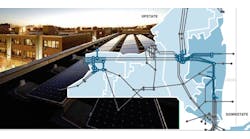Distributed energy resource (DER) and microgrid developers in California and across the country want certainty about their options for — and chances of — interconnecting to the grid.
For years, they’ve struggled with uncertainty that leads to increased costs and causes delays. The developers have had to put their solar projects through an imprecise series of screens to determine whether their projects qualify for a fast-track process from utilities. If not, the projects are subject to expensive interconnection studies and possible utility system upgrades.
A new California Public Utilities Commission (CPUC) resolution takes an important step in addressing these issues — although it doesn’t address all the concerns of developers hoping to interconnect to the grid, said Kenneth Sahm White, a consultant who has been involved in interconnection reform efforts before the CPUC for many years.
The resolution is an outgrowth of a ruling two years ago that established an “integrated capacity analysis” (ICA) that allows developers in California to log into a website with an ICA map, go to a specific location and know with much more certainty whether there’s enough capacity on the system for specific projects. The ICA shows the available capacity that exists at any point on the primary circuits of the grid, and it is updated once a month.
In the past, California utilities — along with utilities across the country — have used a “rule of thumb” screen that wasn’t as precise.
Helps microgrid developers identify project sites
“This is a pretty significant change in the way we think of what the interconnection screening process is,” said Sky Stanfield, a partner with the law firm Shute, Mihaly & Weinberger who represents the Interstate Renewable Energy Council in the effort to change the interconnection process. With increased accuracy and precision, the ICA improves the ability of developers to identify sites where there’s a potential to interconnect — before they spend time and money submitting applications, she said.
The task wasn’t easy and took two years. Pacific Gas & Electric conducted an initial pilot, but had problems with software; about a third of the circuits didn’t have accurate numbers, said White. Eventually the utility improved on its plan, he added.
Still more work needed on ICA
However, the ICA is by no means perfect, said White. He’d like to see an ICA that’s updated in real time, rather than being updated once a month.
“The whole system should be modeled, connected and electronic,” he said. Ideally, it would be a live system in which the model would provide quick results that allow developers to modify their proposals in order to see where they are triggering utility system upgrades — and how much the upgrades would cost.
“The ICA model is a huge step in that direction,” he said. “But it’s not live. It’s a static result run once a month.”
Why not standardized pricing for interconnecting to the grid?
White would also like to see more standardized pricing for interconnection, which would eliminate much of the uncertainty as well as the negotiation process. He noted that residential net metering programs in California have standard pricing for up to 1 MW systems — and those prices help eliminate uncertainty.
Stanfield would like to see an interconnection system that would allow DERs to help out the grid when it’s stressed. That would require an interconnection process that would allow the developers to vary how much energy they send to the grid, depending on the conditions. For example, in August, when demand for air conditioning is high, DERs could provide additional power, she said.
“We won’t achieve that goal to allow DERs to benefit the state and provide power when we need it unless we adopt an interconnection process to reflect the DERs’ capability of doing that,” Stanfield said. Utilities likely worry they don’t have a good enough grasp of conditions on the grid to feel safe allowing projects to vary their capacity based on a model like the ICA.
“Essentially, do they trust the model?” she asked.
A big step
Overall, however, progress is being made. Stanfield has been working on interconnection issues in California since 2011. The original screens that determined whether developers could interconnect their DERs to the grid haven’t changed much — across the country — in the last 20 years, she said. At the same time, DERs have changed dramatically over that time period. That’s why the ICA is an important move in the right direction.
“This is a big step going from static, rule of thumb screens to a more sophisticated way to evaluate projects and enabling them to do it in an efficient manner,” Stanfield said.








